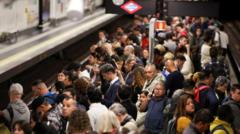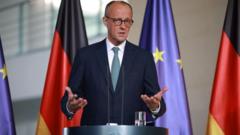Spain is slowly recovering from an unprecedented power outage that blackout the country for nearly 23 hours, affecting millions and raising serious questions about the stability of its energy infrastructure. The national electricity grid officially declared a return to normal at 11:15 AM on Tuesday, with essential services gradually resuming operation.
**Spain's Recovery from a Historic Blackout: A Look at the Aftermath**

**Spain's Recovery from a Historic Blackout: A Look at the Aftermath**
Spain faces critical questions post-blackout. Citizens and officials analyze the unprecedented outage that disrupted daily life across the nation.
The turmoil began on Monday, when simultaneous failures in the power grid, linked to disconnections on the French electricity network, resulted in a staggering loss of 15 gigawatts of power—about 60% of Spain's total generation capacity at that moment. Recognizing the systemic threat, Prime Minister Pedro Sánchez reported the alarming incident that occurred at 12:33 PM, prompting a national crisis response.
Although areas such as the Canary Islands and the Balearic Islands remained unaffected, most of mainland Spain descended into chaos as the grid went dark. Analysts have suggested that Spain's heavy reliance on solar energy—accounting for about 60% of generation just prior to the blackout—may have exacerbated the situation. Critics are calling for a reevaluation of the country's energy mix, especially with increasing saturation from renewable sources.
The recovery operation focused on both northern and southern power-generating regions to initiate a "black start," a meticulously planned process to restore power without overwhelming the grid. Using hydro-electric plants, particularly well-timed pumped-storage systems, and combined-cycle gas plants, Spanish authorities sought to re-energize the entire network while carefully managing load to prevent further collapses.
International cooperation played a crucial role in these restoration efforts. France aided Spain by transferring electricity, gradually increasing flow from 700MW to 2,000MW after tightly managing the reintegration phases. Meanwhile, Morocco contributed significantly with a 900MW transfer across the Strait of Gibraltar.
By Monday evening, nearly 3.5 million customers had their power restored, primarily through grid operator Red Eléctrica and the assistance of neighboring countries. Emergency services, hospitals, and local governments facilitated immediate humanitarian responses throughout the crisis—the Guardia Civil rescued thousands of stranded rail passengers, while grassroots efforts guided individuals to safety in urban areas.
Despite the logistical triumph, the economic impact is estimated to be around €1.6 billion, fueling political contention as parties critique governmental readiness. As citizens rally in support of one another amid the chaos, the government stresses the importance of learning from this crisis to avoid a repeat scenario. However, energy experts caution that Spain's current infrastructure may still struggle to handle its renewable output effectively.
Ultimately, this unprecedented blackout serves as a wake-up call for Spain’s energy dependency and the critical need for a more resilient power grid moving forward.
Although areas such as the Canary Islands and the Balearic Islands remained unaffected, most of mainland Spain descended into chaos as the grid went dark. Analysts have suggested that Spain's heavy reliance on solar energy—accounting for about 60% of generation just prior to the blackout—may have exacerbated the situation. Critics are calling for a reevaluation of the country's energy mix, especially with increasing saturation from renewable sources.
The recovery operation focused on both northern and southern power-generating regions to initiate a "black start," a meticulously planned process to restore power without overwhelming the grid. Using hydro-electric plants, particularly well-timed pumped-storage systems, and combined-cycle gas plants, Spanish authorities sought to re-energize the entire network while carefully managing load to prevent further collapses.
International cooperation played a crucial role in these restoration efforts. France aided Spain by transferring electricity, gradually increasing flow from 700MW to 2,000MW after tightly managing the reintegration phases. Meanwhile, Morocco contributed significantly with a 900MW transfer across the Strait of Gibraltar.
By Monday evening, nearly 3.5 million customers had their power restored, primarily through grid operator Red Eléctrica and the assistance of neighboring countries. Emergency services, hospitals, and local governments facilitated immediate humanitarian responses throughout the crisis—the Guardia Civil rescued thousands of stranded rail passengers, while grassroots efforts guided individuals to safety in urban areas.
Despite the logistical triumph, the economic impact is estimated to be around €1.6 billion, fueling political contention as parties critique governmental readiness. As citizens rally in support of one another amid the chaos, the government stresses the importance of learning from this crisis to avoid a repeat scenario. However, energy experts caution that Spain's current infrastructure may still struggle to handle its renewable output effectively.
Ultimately, this unprecedented blackout serves as a wake-up call for Spain’s energy dependency and the critical need for a more resilient power grid moving forward.





















